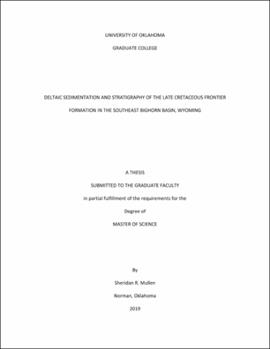| dc.description.abstract | Regional subsurface mapping of the Cretaceous Frontier Formation indicates that it was deposited as discrete deltaic lobes within the Cretaceous Western Interior Seaway (KWIS). The source of sediment was to the west and the deltas prograded eastward in four separate sequences that comprise four Frontier packages. Detailed mapping of over 700 wells in an area of over 43 townships centered around Worland, Wyoming, indicates that sands form distinct delta lobes that prograde from west to east and shift north to south due to differential compaction of underlying sediment. Lobe shifting is apparent between sequences as well as between smaller delta parasequence sets within the major sequences. Sedimentation is also affected by localized tectonics, principally faulting, that causes sediment thins on upthrown blocks. The most apparent tectonic features in the mapped area are the Tensleep fault and the Worland fault, both causing thins in the Fourth Frontier sequence.
Measured surface sections tie directly with adjacent wells and show the stacking relationships of Frontier delta sequences. Four facies observed in the measured sections were 1) silt and mudstones, 2) bentonites, 3) dirty (clay-rich), bioturbated, planar laminated, very fine to fine-grained sands, and 4) thick, amalgamated, cross-bedded sands sometimes capped by coarser grains and chert pebbles. Each Frontier sequence shows a distinct prodelta sequence grading into a lower shoreface sequence, and then into an upper shoreface sandstone. No fluvial sequences were observed in outcrop within the study area. Maximum flooding sequences observed on logs are typically buried in outcrop sections but are easily correlated on logs to provide a regional sequence boundary. Progradation and clinoform geometry appear to be related to eustatic sea-level changes, sediment supply, and subsidence.
Finally, a sequence stratigraphic analysis was performed in a grid over the study area to see the deltaic lobe stacking relations. The grid consists of four cross sections, three dip sections oriented west-east across the study area and one strike section oriented north-south, tying the dip sections. The three dip sections are evenly spaced over the area of interest and the strike section utilizes at least one well from each of the dip sections. After the cross sections were chronostratigraphically correlated, the logs were converted to V-Shale logs to give a better idea of sand-shale distributions as well as depositional facies. In the sequence stratigraphic sections, the building of the delta lobes is clearly evident along with the differential compaction between the different delta lobes causing the deltas to shift back and forth over this portion of the basin. | en_US |
